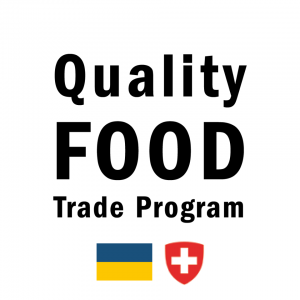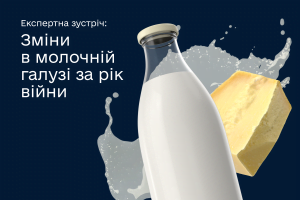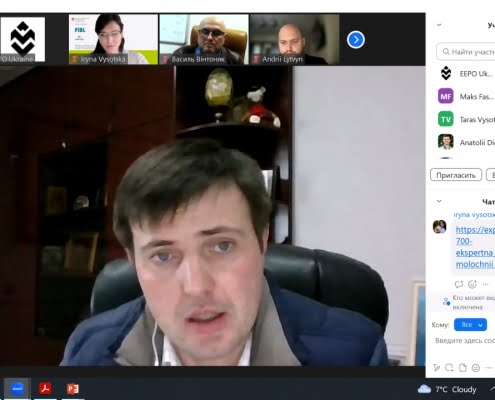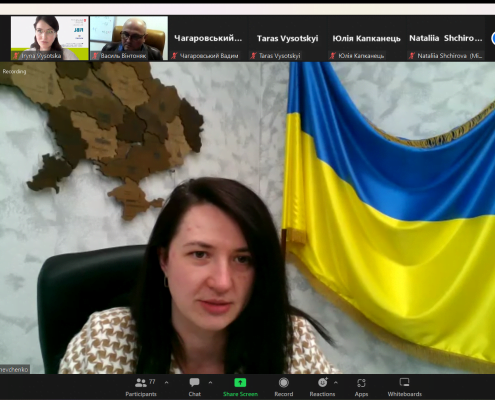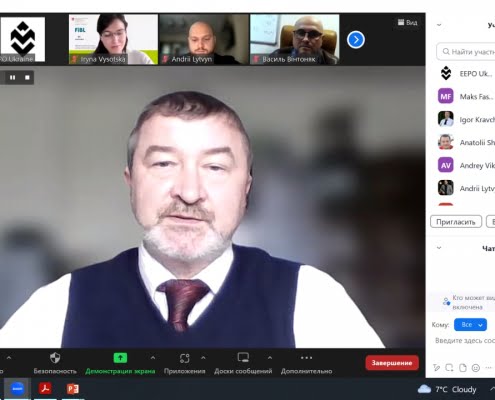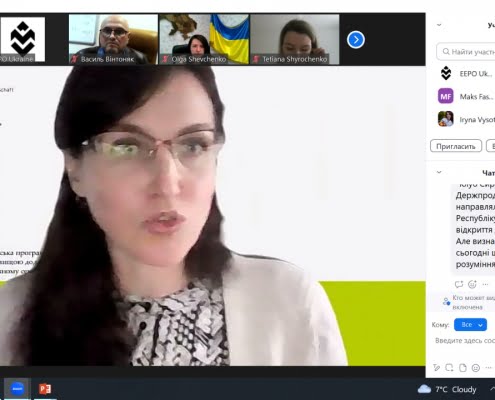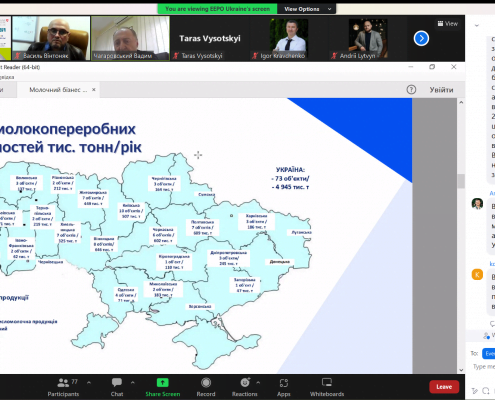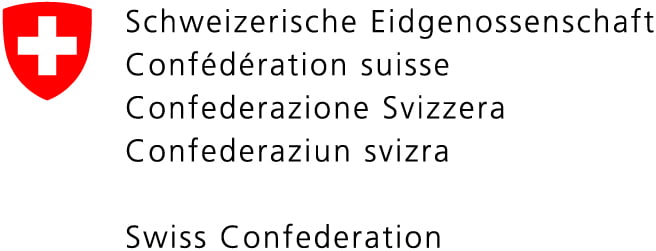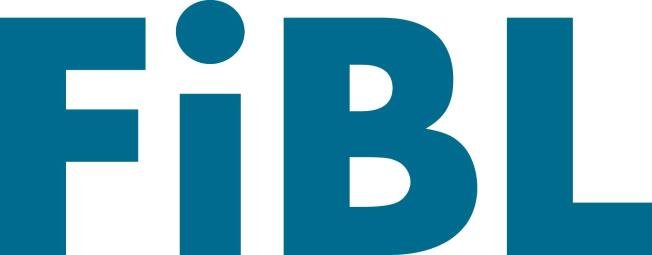In spite of the constant decline in the Ukrainian dairy export over the past three years, the previous 2022 became the year of new growth in the dairy export. With support of the governmental structures and thanks to the prompt assistance of the EU countries, national producers together with traders were able to overcome new challenges caused by the war and even increase export compared to 2021.
On 27 April we talked to the lawmakers and experts about changes and achievements of the dairy sector in production and export during the first of the series of expert meetings for the representatives of the dairy sector dedicated to export support and promotion “Changes in the Dairy Sector After One Year of War”.
The speakers of the event were Taras Vysotskyi, First Deputy Minister of Agrarian Policy and Food of Ukraine, Olga Shevchenko, Acting Head of the State Service of Ukraine on Food Safety and Consumer Protection, Vasyl Vitoniak, Director of INFAGRO Agency, and Vadym Chagarovskyi, Head of the Union of Dairy Enterprises of Ukraine. Iryna Vysotska, Dairy Sector Component Coordinator, Quality FOOD Trade Program, moderated the event.
Taras Vysotskyi, First Deputy Minister of Agrarian Policy and Food of Ukraine, presented the main directions of state support for the industry. Thus, the government continues actively supporting dairy producers. This year it is planned to continue the program that provides for payments per livestock unit for the farms having up to 100 cows. In addition, the government introduces the increased coefficient of payments to the farms situated on the liberated territories or close to the combat zone. The farms affected by temporary occupation or proximity to the combat zone will also receive increased payments. Moreover, compensation for losses of both legal entities and small farms is under consideration.
The grant program, launched by the government last year, continues to work. It makes it possible to receive up to UAH 8 mln for production development. This program includes dairy production and processing. On the program website one can already see several dozens of approved grants, for example, for production of cheese, fermented and other dairy products.
The government is developing simplified procedures for registration and launching production facilities, documentation procedures and other reliefs to support small and medium producers and processors. It is also considering several legislative initiatives to stimulate milk production and processing, in particular, grants to support milk production and processing, reduction of VAT rate to 10% for the entire dairy value chain, including final dairy products, as well as launching the school meals program with obligatory inclusion of dairy products.
Vadym Chagarovskyi, Head of the Union of Dairy Enterprises of Ukraine, presented the main problems of the dairy sector in his speech, namely:
- limited export opportunities for Ukrainian dairy products through the EU;
- higher production costs;
- reduction in the number of domestic consumers;
- loss of production facilities on the occupied territories;
- import of dairy products from the EU, primarily, cheese;
- problems with payments from retail chains;
- lack of an effective lending instrument for the sector;
- suspension of some state programs.
In addition, he talked about the level of export and import of Ukrainian dairy products in 2019-2022 and, separately, the part of Poland. For the detailed data follow the link.
Vasyl Vintoniak, Director of INFAGRO Agency, presented the study of changes in the dairy sector after one year of war:
- in 2022 the proposition of raw milk for processing contracted by about 17%;
- due to migration processes and economic decline the domestic demand decreased by 27% last year, and in 2023 the increase by 10% to the previous year level is possible;
- in spite of expected increase in consumption, to keep the normal balance the export volume has to remain high in 2023 (about 650K tonnes in milk equivalent);
- import volume decreased last year and will not increase significantly this year;
- revenue has increased due to record high prices;
- in 2022 due to the war and destruction of established logistics, export geography had to be changed significantly;
- until last year export to the EU countries was extremely limited, but thanks to the EU’s friendly actions (preferential import…), in 2022 it became possible to increase the total export;
- in recent years (and especially in 2022) butter and related products (milk powder, casein, cheese products) have accounted for the lion’s share of export;
- the most significant drop in exports in 2022 was in the category of inexpensive milk-containing products (cheese products, canned milk, spreads). Due to expensive logistics these products cannot compete on the traditional markets even now.
For the detailed information see the information and analytical bulletin.
Olga Shevchenko, Acting Head of the State Service of Ukraine on Food Safety and Consumer Protection, shared the results and plans of the SSUFSCP in exploring new export markets for Ukrainian dairy products.
Thanks to the geographical proximity to and cooperation with the EU, last year special attention was focused on the European market, but the work on individual markets did not stop. The SSUFSCP is in negotiation and working on entering the markets of Canada, China, and other countries. In 2022 Kenia and the Dominican Republic opened their markets for the Ukrainian dairy products.
“Due to the war this work is becoming more complicated as, for the safety reason, there were no audits in Ukraine either in 2022 or in 2023. We tried to switch to a remote format with some countries and we have successful cases and continue working to expand this nice practice to other counties”, noted Olga Shevchenko.
Olga Shevchenko informed about high activity of producers with regard to adaptation of their production to the European requirements and highlighted that 45 FBOs currently have access to the European market, 19 of which received the permit to export in 2022 and 5 more – in 2023. Therefore, the increasing number of enterprises comply with the European standards.
In May the meeting with participation of over 100 counties is scheduled at the World Organisation for Animal Health. This meeting will become an excellent opportunity to negotiate with individual countries. Producers should identify the priority countries for negotiations.
“Producers can help us to select the countries where they want to export. This will help us to make a relevant plan. For this we welcome the feedback on the countries of interest”, invited the producers the Acting Head.
For the full video recording of the event follow the link.
It should be noted that the series of events has taken place for the second consecutive year. Overall, three meetings are planned with the purpose of adaptation and transformation of the export capacities of Ukrainian dairy producers during the war and given the deteriorating market conditions in 2023 and are aimed at getting together dairy exporters, representatives of national and international sector associations, traders, experts, and consultants.
The second expert discussion “World, Europe, Ukraine — View from the EU” was held on at 14:00 on 10 May. During the meeting the participants discussed the changes in trends in the global dairy market, peculiarities of the EU agri-food market development, current challenges in the industry in Poland and trade relations with Ukraine, and comparison of Ukrainian and global market conditions.
This series of events is conducted by the State Enterprise “Export and Entrepreneurship Promotion Office”, national project Diia.Business and analytical agency INFAGRO with support of Switzerland in the frame of the Swiss-Ukrainian Project “Higher Value Added Trade from the Organic and Dairy Sector in Ukraine” implemented by the Research Institute of Organic Agriculture (FiBL, Switzerland) in partnership with SAFOSO AG (Switzerland).
